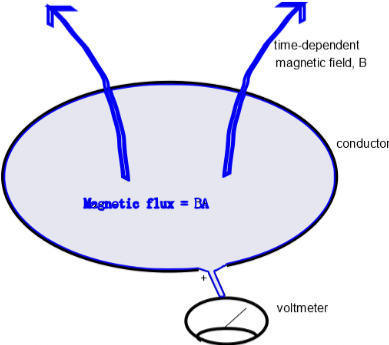US Patent 7,791,353 B2
Introduction
Simple Circuit Concepts
Transmission lines
Faraday's law
Near and far fields
Spurious coupling mechanisms
- Direct conduction
- Capacitive coupling -problem
- Capacitive coupling -fixing
- Inductive coupling-problem
- Inductive coupling -fixing by twisted
- Inductive coupling -fixing by coax
- Electromagnetic pickup
- Examples
- Safety & star grounding
- Gnd loop resistance, inductance
- Low frequency behavior
- High frequency behavior
- Troubleshooting
- Methods for removing
Faraday's law
Faraday's law, a fundamental law and experimentally demonstrated law of physics, is sketched to the right. This law states that when a conducting loop with a gap links a time-dependent magnetic flux F, a voltage V= -dF/dt appears across the gap. Here dF/dt is the time rate of change of the linked flux F=BA, where B is the magnetic field strength and A is the area linked by the conducting loop. The voltage across the gap is measured by a voltmeter, but is not a potential difference because this voltage cannot be expressed as a function of local position like altitude on a topographic map. Faraday's law is the basis of transformers, electric generators, and together with a generalized form of Ampere's law, of electromagnetic waves. Despite its fundamental nature, Faraday's law is ignored in electronic circuit theory except when used to characterize the behavior of discrete inductors or transformers. When time-dependent magnetic flux links a circuit, Kirchoff's voltage law must be replaced by Faraday's law in order to have a correct description of what is actually happening.
Faraday's law, a fundamental law and experimentally demonstrated law of physics, is sketched to the right. This law states that when a conducting loop with a gap links a time-dependent magnetic flux F, a voltage V= -dF/dt appears across the gap. Here dF/dt is the time rate of change of the linked flux F=BA, where B is the magnetic field strength and A is the area linked by the conducting loop. The voltage across the gap is measured by a voltmeter, but is not a potential difference because this voltage cannot be expressed as a function of local position like altitude on a topographic map. Faraday's law is the basis of transformers, electric generators, and together with a generalized form of Ampere's law, of electromagnetic waves. Despite its fundamental nature, Faraday's law is ignored in electronic circuit theory except when used to characterize the behavior of discrete inductors or transformers. When time-dependent magnetic flux links a circuit, Kirchoff's voltage law must be replaced by Faraday's law in order to have a correct description of what is actually happening.

Find ground loops fast!
-eliminate electical interference, fix star grounding
-eliminate electical interference, fix star grounding
US Patent 7,791,353 B2
Fig. 3 Faraday's law: voltmeter reads voltage V= -dF/dt where F=BA; there is no potential.
For quotes, purchase orders, shipping outside USA, questions contact
Circuit Insights LLC, Pasadena, California, USA
Email: sales@loopslooth.com Tel: 626-201-0488